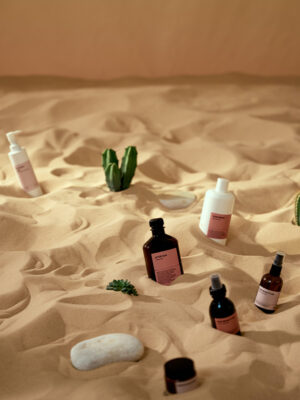While it’s a bit of a scientific mess, we do, over time, come to recognize the various cosmetic ingredients that make up our favorite skincare products. When instead we talk about SPF, the maneuver is a little more substantial. To make things easier for you, we’ve deciphered for you most of the big names you’re likely to find in your favorite body and face formulas… Go!
Titanium dioxide and zinc oxide = mineral filters
These two ingredients are part of mineral filters. These are natural sunscreens that do not penetrate the skin but remain on its surface to reflect light. This is also why they generally form a white film on the surface of the epidermis. Dermatologist Kristina Goldenberg considers them gentler on the epidermis. She explains to reporters about Byrdie :
“Mineral or natural sunscreens are less irritating than chemical sunscreens. If you have sensitive skin, look for formulations containing physical blockers. »
If there are no particular contraindications with zinc oxide, titanium dioxide raises questions. In a service on the matter, Inci Beauty reports that in 2006, “The International Agency for Research on Cancer (IARC) has classified titanium dioxide TiO2 in the group of substances “possibly carcinogenic to humans” (group 2B): whether inhaled regardless of particle size Nano or not”.
If you see it in a sun spray: choose another one. If, on the other hand, it is present in a body cream, know that you don’t have to take any risks.
Avobenzone and octocrylene = chemical filters
There are many chemical filters. These act very differently from so-called mineral filters. Their main selling point? Absorbs UV rays so that they do not “burn” the epidermis. But which ones are most often found in commercially available creams and sprays? Well, among the 21 options that can be offered to you, there are 5 which are very often used by big brands.
First there is the Butylmethoxydibenzoylmethane (also called Avobenzone) which is present in 67% of compositions. The latter is a polluting filter that tends to degrade and become an endocrine disruptor.
There is also Octocrylene, which is included in 54.7% of formulas. Unfortunately, this ingredient tends to turn into benzophenonea genotoxic, carcinogenic and endocrine disrupting compound, according to the scientific journal Chemical research in toxicology.
Ethylhexyl Salicylate, Bemotrizinol and Ethylhexyl Triazone they are also among the most used chemical filters by the big cosmetic brands. They are all, without exception, endocrine disruptors.

Triethanolamine = an odor masker
Triethanolamine, more commonly known as TEA, is an amine used for stabilize the formula by neutralizing the carbomers to obtain a gel. But it also allows you to mask the smell of a product, balance the pH and evenly distribute the product thanks to its surfactant capabilities. In short, it is the ingredient to do everything. Unfortunately, according to techno-science.net, it is poorly tolerated by the most sensitive skin and can become carcinogenic if its concentration exceeds 2.5% in a product… What is rare in France where most formulas contain only 1%. But keep an eye out.
Disodium EDTA = a stabilizer
Disodium EDTA helps maintain the stability and viscosity of a sunscreen product. If this ingredient does not harm human health, it has, according to Inci Beauty, a problematic impact on the environment because it is not biodegradable and wastewater treatment plants are unable to filter it.
Phenoxyethanol = a synthetic preservative
Phenoxyethanol makes it possible maintaining the stability of a cosmetic product (not just sunscreen) e it also prevents the proliferation of bacteria in formulas related to beauty and hygiene. What you need to know is that since 2012, the ANSM (National Agency for the Safety of Medicines and Health Products) has recommended not to use this preservative in cosmetic products intended for the buttocks of newborns. .
On the Inci Beauty website we even read that the ANSM “It also denounces its liver toxicity, its potentially harmful effects on reproduction as well as many other drawbacks: the conclusions of the 2012 ANSM report are alarming. » But what you need to know is that these health effects depend on the concentration of phenoxyethanol used. Limited to a maximum concentration of 1% in a formulaIt is often used in lower doseswhich makes it perfectly harmless except for people who have a skin reaction (rash, psoriasis, eczema).
The Federation of Beauty Companies believes so “to overcome the dose without effect, for a 57 kg woman (average weight according to them), 47 jars of face cream should be applied to the skin EVERY DAY, every day”. A priori, we have the margin.
Tocopherols = antioxidants
Tocopherols are a set of antioxidants derived from vitamin E which is most often found in tanning oils. In cosmetics, they simply help maintain the balance of a formula when it comes into contact with oxygen. They generally come from palm, sunflower or wheat germ oil, but can also be created in a laboratory. After several scientific studies reported by Inci Beauty, it was found that tocopherols are harmless to human health. We are reassured.
An image credit: @MSKIN.
Source: Madmoizelle
Elizabeth Cabrera is an author and journalist who writes for The Fashion Vibes. With a talent for staying up-to-date on the latest news and trends, Elizabeth is dedicated to delivering informative and engaging articles that keep readers informed on the latest developments.




